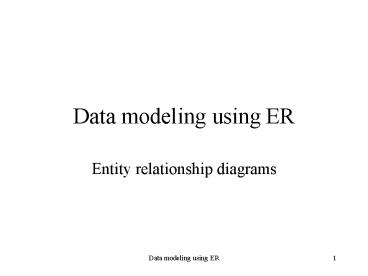Entity relationship diagrams - PowerPoint PPT Presentation
1 / 20
Title:
Entity relationship diagrams
Description:
Data modeling using ER Entity relationship diagrams Data modeling using ER * Data modeling using ER * Why analyze data? Insight in data - and structures of data. – PowerPoint PPT presentation
Number of Views:306
Avg rating:3.0/5.0
Title: Entity relationship diagrams
1
Data modeling using ER
- Entity relationship diagrams
2
Why analyze data?
- Insight in data - and structures of data.
- Create a structure in unstructured data
- Prior to designing a database
- A part of the systems development process.
3
ER modeling
- ER modeling is a widely used technique for data
analysis. - Many notations (syntax) for ER diagrams
- Different book ? different notations
- Diagrams can be drawn using Visio or a similar
tool.
4
Entities with attributes
- Characteristics of an entity
- An important thing in the world we model.
- Entities have attributes (data)
- Similar to a class in OOA, but has no methods /
functions. - Notation (this book)
- Entity Rectangle
- Attribute Oval
5
Types of attributes
- Simple or composite attributes
- simple (atomic) e.g. age
- Notation Oval
- composite
- address street number ZIP code town
- Notation Oval connected to several sub ovals.
6
Types of attributes II
- Single valued or multi-valued
- Single valued e.g. CPR
- Multi-valued e.g. phone number
- One person may have several phones
- Notation Double oval
- An attribute may be composite and multi-valued!
7
Types of attributes III
- Derived Calculated from other attributes e.g.
sum or average - Notation Oval with a dashed border
- An attribute with no value has value NULL
- Values does not exist.
- Value unknown.
8
Entities
- An entity type is like a class
- Naming convention Substantive, singular
- Every instance of the entity must be unique
- Identified by a key, one or more attributes
- Notation for keys Underline the name of the
attribute(s)
9
Relationships
- Relationships between entities.
- Notation Rhomb
- Similar to association in OOA.
- Relationships may have attributes
- Notation Oval
10
Relationships II
- Binary relationship
- Relationship between 2 entities (normal)
- Relationships, higher degree
- Relationship between more entities (rare)
- Recursive relationships
- Relationship of 2 entities belonging to the same
entity type e.g. an employee with a relation to
another to a boss (another employee)
11
Cardinality
- 1-1 very rare
- 1 entity of type A has a relation to at most 1
entity of type B and vice versa - 1 husband 1 wife
- 1-many, 1-N very common
- 1 entity of type A may have relation to many
entities of type B, not vice versa. - 1 department many employees
12
Cardinality II
- Many - many, N-M common
- 1 relation of type A may have relations to many
entities of type B and vice versa. - 1 employee many projects
- 1 project many employees
13
Cardinality notation
- Step into the entity type and look at the other
entity through the relation. - How many entities of the other type do you see?
- Write the number on far end of the relation.
14
(min, max) cardinality
- Often youre only concerned with max.
cardinalities. - Sometimes you want both (min, max) cardinality.
- Note Cardinalities placed in the other end of
the relation!!!
15
History
- History More generations of relations
- Cardinality goes up
- 1 man many wives not simultaneously
- Put a timestamp / period on the relation
(attribute on the relation) - Relation marriage start_date, end_date
- end_date may be NULL -)
16
Total participation
- Ordinary relation
- An entity may be related to another entity.
- Total participation
- En entity must be related to another entity.
- Min. cardinality 1 (not 0)
- Notation Double line on the relation
17
Weak entities
- An entity that is dependent on some other entity.
- If the strong entity is deleted so is the weak
entity. - Notation
- Weak entity Rectangle with double borders
- Identifying relationship Rhomb with double
borders (shows the strong entity)
18
Weak entities II
- A weak entity has a partial key
- Not unique
- Unique in combination with the key from the
strong entity. - Notation Dashed line under the partial key.
19
Diagramming tools
- Drawing
- Microsoft Visio now a part of MS Office
- Diagramming to generate tables
- You draw ER, the tool generates tables
- Reverse engineering
- You have the tables, the tools generates ER.
- Dont use tools early in the process - use pen
and paper!!!
20
Best practice
- Procedure (best practice)
- find entities and easy attributes
- relationships
- cardinalities
- keys
- weak entities
- total participation































